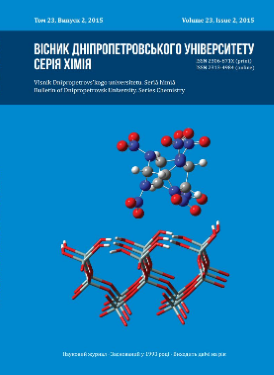Tertiary amines nucleophilicity in quaternization reaction with benzyl chloride
DOI:
https://doi.org/10.15421/081513Keywords:
hydrazide, nucleophilicity, tertiary amines, quaternization, reversible processesAbstract
Quaternization reaction of tertiary amines with benzyl chloride was investigated. Reaction orders with respect to the reactants were determined. Kinetic scheme of quaternization reaction was found to be corresponding to reversible process. An influence of amines basicity and steric factor of alkyl substituent bound to the nitrogen atom on tertiary amines reactivity as nucleophiles was studied. It was shown that the rate constants of direct reaction step may serve as a measure of nucleophilicity of amines.References
Mingfa, Y., Tao, W., Na, Q., & Daping, Q. (2012) Controllable ring-opening polymerization of trimethy-lene carbonate catalyzed by aliphatic tertiary amines in the presence of benzyl alcohol or F127. Polymer International, 61(10), 1525–1531. doi: 10.1002/pi.4240
Kas'yan, L. I., Turov, A. V., Karat, L. D., Prid'ma, S. A., Pal'chikov, V. A., Svyatenko, L. K., & Okovityi, S. I. (2011). Experimental and theoretical study on the reaction of bicyclo[2.2.1]hept-5-en-endo-2-ylmethan-amine with glycidyl ethers. Russ. J. Org. Chem., 47(1), 74–82. doi:10.1134/s1070428011010088
Sinelnikova, M. A., Shved, E. N., Usachov, V. V., & Oleynik, N. M. (2010). [Modeling the mechanism of amine catalysis of epichlorohydrin acidolysis with aliphatic and aromatic carboxylic acids]. Teor. i eksp. khim. – Theoretical and experimental chemistry, 46(3), 164–170 (in Russian).
Choe, Y.-S., Park, S.-W., Park, D.-W., & Kim, S.-S. (2010). Reaction Kinetics of Carbon Dioxide with Phenyl Glycidyl Ether by TEA-CP-MS41 Catalyst. J. Jpn. Petrol. Inst., 53(3), 160–166. doi: 10.1627/jpi.53.160
Klopman, G. (Ed.). (1974). Chemical Reactivity and Reaction Paths. New York: Wiley.
Palm, V. A. (1977). [Fundamentals of quantitative theory of organic reactions]. Leningrad, USSR: Khimiya (in Russian).
Zhou, X.-Y., Rong, C.-Y., Lu, T., & Liu, S.-B. (2014). Hirshfeld Charge as a Quantitative Measure of Electrophilicity and Nucleophilicity: Nitrogen-Containing Systems. Acta Physico-Chimica Sinica, 30(11), 2055–2062. doi: 10.3866/PKU.WHXB201409193
Takayama, C., Fujita, T., & Nakajima, M. (1979). Quantitative separation of electronic and steric substituent effects in reactions between aliphatic amines and electron acceptors. J. Org. Chem., 44(16), 2871–2879. doi: 10.1021/jo01330a011
Firago, D. S. (2011). [Kinetic study of quaternization reaction of 1-methylimidazole with 1-brombutane in acetonitrile]. Sb. rabot 67 nauchnoy conf. stud. i asp. BGU, 17-20.05.2010, Minsk. V 3 ch. Ch. 1. – Works digest of 67th student and post-graduate student scientific conference of Belarus State University, May 17th–20th 2010, Minsk. In 3 parts. P. 1. Minsk, Belarus. 221–225 (in Russian).
Arnett, E. M., & Reich, R. (1980). Electronic effects on the Menshutkin reaction. A complete kinetic and thermos-dynamic dissection of alkyl transfer to 3- and 4-substituted pyridines. J. Amer. Chem. Soc., 102(18), 5892–5902. doi: 10.1021/ja00538a031
Juravlyov, O. E., Verolaynen, N. V., & Voronchihina, L. I. (2012). [Synthesis and biological activity of N-alkyl-piperi-dinium quarternary salts]. Vestn. Tver. Gos. Univ.: Khim. – Bull. Tver State University: Chem., (14), 78–85 (in Russian).
Bekker, H., Bekkert, R., Berger, V., Gevald, K., Gents, F., Gluh, R., Domshke, G., Zailer, E., Mayer, R., Mets, P., Muller, K., Pafel, D., Faighenel, E., Faust, Yu., Fisher, M., Habiher, V., Shvetlik, K., Shmidt, G., Sholberg, K., & Tseppenfeld, G. (1992). [Organicum]. Moscow, USSR: Mir (in Russian).
Nikolsky, B. P. (1964) [Reference Book in Chemistry]. Moscow–Leningrad, USSR: Khimia (in Russian).
Umland, F., Yansen, A., Tirig, D., & Vyunsh, G. (1975). [Complex compounds in analytic chemistry. Theory and practice of using]. Moscow, USSR: Mir (in Russian).
Downloads
Published
Issue
Section
License
Copyright (c) 2015 Oles Honchar Dnipropetrovsk National University

This work is licensed under a Creative Commons Attribution 4.0 International License.
- Authors reserve the right of attribution for the submitted manuscript, while transferring to the Journal the right to publish the article under the Creative Commons Attribution License. This license allows free distribution of the published work under the condition of proper attribution of the original authors and the initial publication source (i.e. the Journal)
- Authors have the right to enter into separate agreements for additional non-exclusive distribution of the work in the form it was published in the Journal (such as publishing the article on the institutional website or as a part of a monograph), provided the original publication in this Journal is properly referenced
- The Journal allows and encourages online publication of the manuscripts (such as on personal web pages), even when such a manuscript is still under editorial consideration, since it allows for a productive scientific discussion and better citation dynamics (see The Effect of Open Access).


